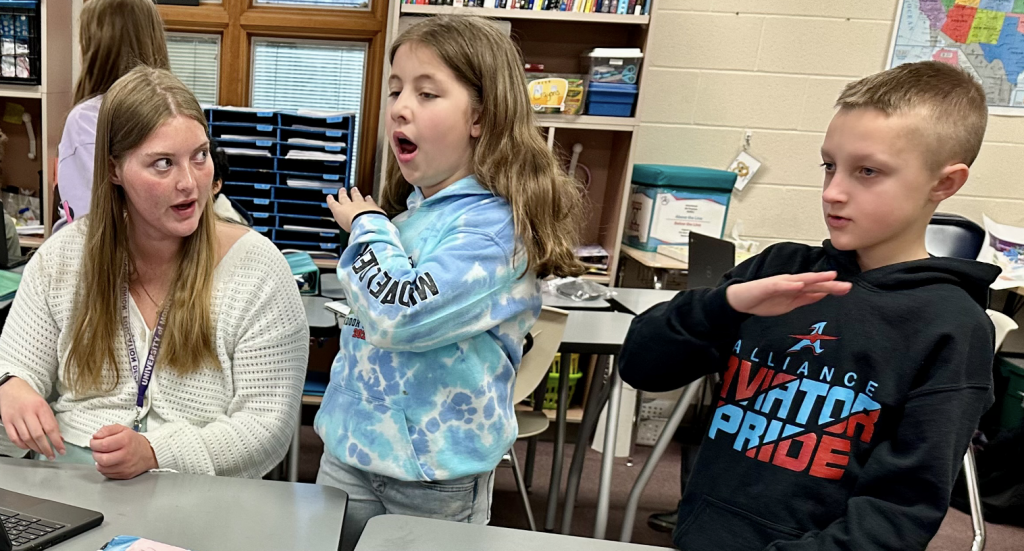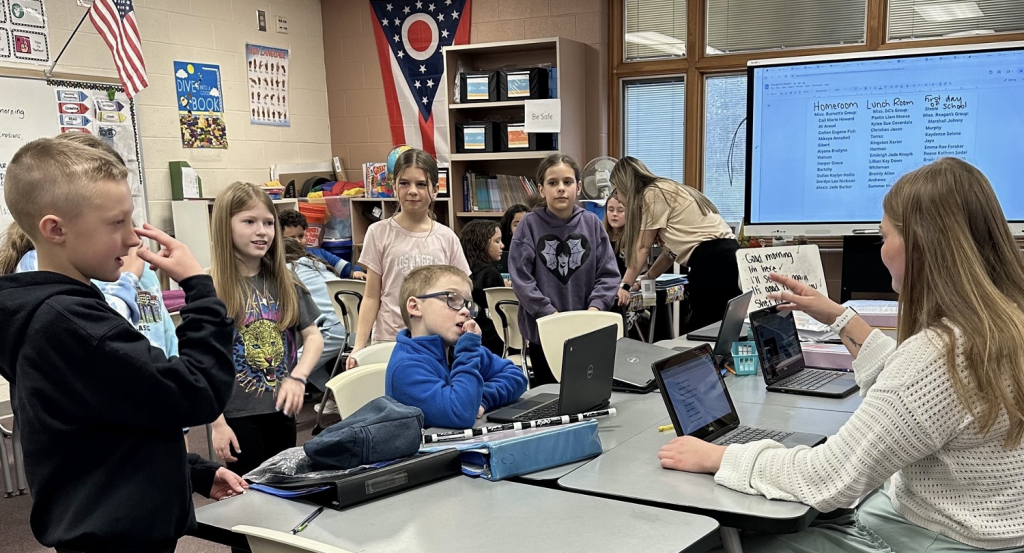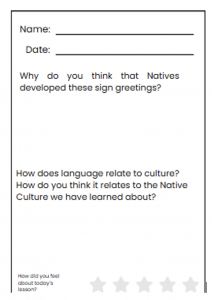

UMU Lesson Plan—Native American signs and words in contemporary scenarios/role plays
Main resource used in this lesson plan from ahtove.org
View complete lesson plan below
Authors: Alyssa Denniss-Crespo, Jillian Burnett, Abby Reagan | Native American Language Role Play |
Grade Level: 4th grade | Class Period: Block 1 |
Context for Learning
This lesson was taught to a diverse group of 25 fourth graders, including multiple students of color and two students with IEPs. There are lots of varying family styles, with most students from a lower socioeconomic background. These students enjoy working in groups and hands-on activities.
This lesson builds on Vygotskian social construction theory because it encourages students to learn through collaboration and creative social interaction with their peers. This lesson taps Howard Garner’s Theory of Multiple Intelligences by engaging students in various ways: they research (linguistic intelligence), work together (interpersonal intelligence), and perform the roleplay (bodily-kinesthetic intelligence).
In this lesson, students will use the Ahtove website to explore and research Native American signs used by Native people. This allows students to access digital resources to deepen their understanding of non-verbal communication and cultural greetings. By utilizing the website, students can independently find relevant information, enhancing their research skills and understanding of Native communication methods. They can then build on this skill by sharing their findings with their small groups, and using their findings to be implemented in their role play presentations.
According to Ohio Technology Standard 1: “Students will use technology tools to enhance learning, research, and communication.” This lesson aligns with the standard as students will use technology to research Native American signs, collaborate in groups, and present their findings, integrating digital resources into their learning process. (Ohio’s Learning Standards for Technology)
Content Standard:
Ohio SS.5.2 Early Indian civilizations (Maya, Inca, Aztec, Mississippian) existed in the Western Hemisphere prior to the arrival of Europeans. These civilizations had developed unique governments, social structures, religions, technologies, and agricultural practices. Ohio’s Learning Standards for Social Studies
Learning Objectives:
By the end of the lesson, students will research and identify at least five greeting signs used by Native American people and accurately incorporate these signs into a roleplay scenario with 80% accuracy in their roleplay demonstration.
After the completion of small group roleplay using the Native American signs, students will explain how sign language ca represent culture.
Academic Language:
Cultural Greetings – The ways people say “hello” or greet each other in different parts of the world, often using special hand signs or gestures.
Native Sayings – Special words or phrases that people from Native cultures say, often to share important ideas or traditions.
Role-Play – Pretending to be someone in a made-up situation to practice how to react or speak in real life.
Scenario – A story or made-up event that helps you practice what you would do in real life.
ASL Signs – Special hand gestures and movements used to talk in American Sign Language, instead of using your voice.
Signs to be modeled/taught in this lesson:
Good morning- A way to greet someone/say hello early in the day
Good Day- A general way for greeting someone
Good Afternoon- A way to greet someone/say hello after morning
Good Evening- A way to greet someone.say hello later in the day but before night
Good Night- A way to say goodbye/end a conversation at the end of the day. Typically you would say this before bed
I’m here- Announcing your presence
He/She is not here- Saying someone else is not present
It’s good to see you- Saying it’s nice to see someone
I’ll see you again- Saying you’ll see someone another time
Assessments:
-As students do independent discovery and watch the primary source videos to learn the signs and practice their role plays, teachers will join their groups a few times throughout the lesson and show them a few greetings and ask the students to demonstrate the greeting. If any students seem to struggle with the signs, they can be re-taught in small groups or individually.
-At the end of the lesson a small group of students from each group will come up to the front of the room and present their role play that they worked on in their groups. This is to show demonstration of understanding of content
-Students will be completing an exit ticket to reflect on what they learned and how they felt using the signs and translating. This exit ticket will consist of two questions along with having the students give a 5 star rating. These questions will be collected to see the students learning throughout the lesson.
Lesson Introduction: (5-10 Minutes)
- Explain the importance of cultural greetings and native sayings, and how these greetings play a role in building communication and relationships in different cultures with the following: “Imagine meeting someone new and communicating without saying a word—just with your hands! Today, we’ll learn how to greet and communicate like Native American people using Native American signs”
- Emphasize that this is NOT ASL and that this is a form of communication Native Americans use across tribes if they don’t know their language, not because they are deaf.
- Students will be broken up into three random groups, each paired with a teacher, if possible
- Ensure each group has a role-play card with a different scenario.
- We will then give instructions on how to access the Ahtove website, where students can explore and research Native American signs.
Lesson Body: (45 Minutes)
- Each group will have a different current-day roleplay scenario. For example, one group could act out a scenario like a first day at school, while another group might act out a meeting at a community event, and the third group could simulate a greeting between friends.
- Guide each group in researching the Native American signs used by Native people. Teachers can assist students in finding the signs that match the greetings or actions needed for their roleplay. Students will be using the Ahtove website for this portion.
- We will remind students that they should focus on using the Native American signs and gestures to help tell their story in the roleplay, and each student in the group will have a specific role to play in the scenario.
- Students will work together to create their roleplay scene, incorporating the Native American signs they researched. They should practice the signs with their group members and plan how they will act out their roleplay in front of the class.
- Circulate around the groups to check for correct sign usage and provide support as needed. They will encourage creativity and teamwork, ensuring that all students are engaged in roleplay preparation.
- At some point throughout their lesson, stop to assess that the students are mastering signs in their groups. Each group will be working on different signs/scenarios, so assesses different signs such as: Good morning, Good afternoon, It’s good to see you, I’ll see you again, and He/she is not here
- Give students time to rehearse their roleplay, reminding them that they will perform it for the entire class, so they should feel confident in using the signs and acting out their scenario.
- Students will present their roleplay to the class. Each group will perform their scenario, using the Native American signs they researched to communicate their story.
- If there is extra time, mix up the groups and re-do role plays with different student teams. This will allow students to work with others they haven’t collaborated with before. For our above-level learners, it’s a chance to take on leadership roles and help others, which can deepen their understanding and provide them with a new challenge.
Lesson Closure: (5-10 Minutes)
- Gather the class together after all the groups have presented their roleplays.
- Students will share their thoughts on the roleplay presentations. They will discuss which Native American signs they found most interesting and how they used them to communicate in their scenes.
- We will lead a brief class discussion about how the Native Americans signs helped students communicate without speaking and how gestures can be powerful tools for building connections.
- Students will complete a self-reflection sheet, where they will answer questions about how well their group worked together, what signs they learned, and how they could improve their performance in the future.
- Help students with self-reflection by providing guidance on how to answer the questions thoughtfully. They will also encourage students to think about how they can use Native Americans signs in other settings.
- Thank the students for their hard work and creativity. Remind them that learning new ways to communicate can help them connect with others in meaningful ways.
Instructional Materials and Support:
Ahtove Website – A digital resource for exploring Native American signs used by Native people.
https://ahtove.org/greetings-with-sign-language-marty/
Role-Play Cards – Cards with different scenarios for each group to act out using Native American signs.
Markers and Paper – For students to brainstorm and write down their ideas for the roleplay.
Projector/Board – To display group assignments and any additional instructions.
Self-Reflection Sheets – A sheet for students to reflect on their teamwork and the signs they learned.
Computers/Tablets – Devices for students to access the Ahtove website and conduct research

